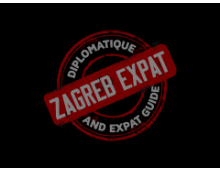HISTORY
Early History
The first settlement to be called Zagreb developed on the east bank of the Medveščak stream (covered over in the 1880s and now Tkalčićeva street). The bishopric was founded here in 1094 and the first small church was built. The area was known as Bishop's Kaptol. When Mongol Tartars inavded in 1241, some of the Kaptol inhabitants decided to build a safer, tortified settlement on the higher hill across Medveščak stream. They named this new area Gradec and in 1242 the king, Bela, issued a 'Golden Bull' proclaiming in the Royal Free City of Zagreb.In the later half of the 13th century, work began on the church, wich was later to become Zagreb Cathedral. Remains of the fortifications built around Kaptol can still be seen today.
The Austro-Hungarian influence
In the 16 th century the Croatian throne passed to the Hapsburg dynasty and the influence of the Austrian Empire began. The advance of the Turks into the region was effectively contained behind the military frontier (Krajina) established by the Austrians, closely along the lines of the current border between Croatia and Bosina-Herzegovina, with Karlovac as the major garrison town. As a result of this frontier, Croatia developed as a Catholic country with little in common with its southern neighbors. Bosnia and Serbia where subjected to the suffocation of the Ottoman Empire and there, in parallel with the Islamic influence, the Orthodox churches developed and extended their power.
Dalmatia, with the exception of Dubrovnik, the islands and Istria, was subjugated under Venetian rule for much of the time during the 11th to 18th centuries. Zagreb, however, was an integral part of the Hapsburg Empire and developed as a city along classical Austrian lines, as did other provincial capitals in the Empire. This is why today it looks much like Graz or even a mini Vienna. By complete contrast, Trogir, Korčula and other coastal cities have a distinct air of Venice, but without the canals.
The laissez-faire Hapsburg regime was a relatively easy yoke to bear and allowed some scope for the development of Croatian identity and institutions. The University in Zagreb was founded in 1669. In the 17th and 18th centuries, the Upper Town (Gradec) developed as the administrative and business center. Noblemen and their families began to build the first houses in the baroque style, using brick and stone rather than wood. The first proper plans were drawn up for the Lower Town.
During the 19th century, the influence of the Hapsburg’s increased and extended to the coast, following the collapse of Venetian influence at the hands of Napoleon. However, the nature of the Empire changed when, under the power-sharing compromise between Austria and Hungary,
Croatia became part of the Austro-Hungarian Empire. Control was alloyed to the Hungarians. This began an intense and resented phase of Magyarisation (Hungarian-isation) in Croatia, which permeated every corner of life and culture.
The Croatians were moved to arms in resistance oto this oppression. In 1848 Ban Jelačić united the Hungarian controlled provinces of Croatia and was able to liberate the country from what had effectively become an occupation. The statue in the main square today commemorates his success. The result was a more reasonable relationship with the Empire, and Croatians were able to regain their own identity, culture and language.
In 1850 Gradec and Kaptol were formally united, both politicaly and administratively. By now Zagreb had a population of around 17,000. Maksimir, the first public park in this patr of Europe, was opened. In 1886 the South Slav Academy of Arts & Sciences was founded. This was the era when all the main squares and formal buildings of the Lower Town were laid out, in a variety of styles. The Croatian architect, Herman Bolle designed the magnificent cemetery at Mirogoj (1876) and the Arts and Crafts Museum (1891). Others were responsible for the Railway Station (1892) and the National Theatre (1895). Following a severe earthquake by in 1880, the reconstruction of the Chaterdal was supervised by Bolle and included the two neo-Gothic towers you see today.
Yugoslavia
A totally new and distinctive phase of Croatian history began after the First World War. Encouraged by many intellectuals, the western powers facilitated the creation of the Kingdom of Serbs, Croats & Slovenes, later called Yugoslavia. There was a local king available, as the Karađorđević family had established hereditary rights to the throne in Serbia. However, what had begun as an enlightened sponsorship of democratic monarchy, gradually became a royal dictatorship, driven by Serbian interests. The Kindgom, detested in much of Croatia, was ended with outbreak of the Second World War, which led to the immediate collapse of the Government and the flight of the King of Yugoslavia to London.
The vacuum was immediately filled by the Ustashe regime taking power in Zagreb. Led by Ante Pavelić, the movement was fuelled by Croatian resentment of their subjugation to Serbia. The Pavelić regime became a puppet state, answering to Hitler initially through the Italians. Next began the brief period of fascist history in Croatia, with exterminations, expulsions and executions following similar patterns to those in Romania, Hungary and mainland Greece.
In the whole of Yugoslavia there was huge resistance, variously against the former Kingdom, the Germans and the Italians. The two main bands, the chetniks and the partisans, where fighting each other for control of the resistance movement and also for control of the country they were trying to liberate. With the support of Churchill, it was the partisans who were ultimately successful and, once the British to them trough the islands. The death toll in Croatia was enormous: 1.5 milion people died in the Second World War, 1.2 milion of them civilians.
By the time the country was liberated, the cellular structure of a communist state was largely in place. Tito, a Croatian of Slovene origin who had led the partisans, was made lifelong president of the liberated country. The rivalries and aspirations of the different nationalities continued, but Tito had a simple formula for demands of Serbia for greater influence were accommodated with key positions in the federal structures, the army and the police. Demands for a national identity, whether by Serb, Croat or Bosnian, were dealt with by repression and imprisonment.
As a result of the agreement between Stalin and Churchill, Yugoslavia never fell behind the Curtain and the brand of communism which developed was a very different one. After Tito's break with Stalin, Yugoslavia effectively severed many of its connections with the Communist world. Croatians were positively encouraged, largely for economic reasons, to travel abroad and foreign tourists also began to visit the country in large numbers. Croatians, especially those in Zagreb, continued to have much greater access to and interest in the West.
After Tito's death in 1980, the precarious structure of the Federal Republic was held together largely by the army, the Communist party and the secret service, despite the largely paralyzed government. The hole edifice began to collapse as the Communist parties expired through Eastern Europe.
Croatian independence
This gave openings to nationalist political movements, both in Slovenia and Croatia, where under the leadership of Franjo Tuđman (one of the many who had been imprisoned by Tito), the HDZ was able to sweep to power with huge popular support in 1990.
In the same year the statue of Ban Jelačić, which had been removed by the communists in 1947, was erected again in Zagreb's main square, pointing not towards Hungary as before, but towards Serbia.
The subsequent declaration of Croatian independence provoked the infuriation of the Yugoslav Army, whose command was dominated by the Serbians. After a brief struggle in Slovenia in June 1991, this led to the war in Croatia.
Zagreb and Croatia's war
There are few signs of material damaged in Zagreb and it is easy to imagine there was no war here. However, war did come to Zagreb in September 1991. Croatians besieged the Yugoslav Army installations and barracks to try to force a withdrew and there was gunfire in the city, with sniping from many of the Army apartments. On October 7th, air-fired rockets struck the President's office in the Upper Town. The Yugoslav Army finally withdrew from Zagreb, but whitin weeks Croatia had lost one third of its territory to the Serbs and the front line was in Karlovac. Only after Operation Storm(Oluja), which lasted for just a few days in the summer of 1995, were the occupied areas almost completely recovered.
Unlike so many cities, zagreb came under direct rocket attack only once, but its people lived continually with the reality of war and in the shadow of the guns. ( In the rocket attack in 1995, eleven died in the streets). Men from Zagreb made up most of the first hastily assembled army units and suffered many casualties. By May 1993 there were 130,000 displaced people and refugees living in Zagreb and the population of the city reached one milion. Visible signs of the destruction caused by the war begin just outside Zagreb, but there are invisible signs in the lives of all those who lived here; few residents were untouched.
The final years of Tuđman's regime were marked by monopolization of power, cronyism and, increasingly, the appearance of dictatorship. There was a landslide vote for change, wich overwhelmingly defeated the HDZ in the elections of January 2000. The succeeding government, a coalition, made some progress but was unable to deliver to the satisfaction of the electorate.
The HDZ, having been substantially reformed meanwhile, was re-elected with an absolute majority in November 2003.





Add a comment
Komentiranje je dopušteno samo registriranim korisnicima. Da biste mogli ostaviti svoj komentar, trebali biste se prijaviti kao registrirani korisnik. Za prijavu koristite link "Prijava korisnika".Ako nemate korisničko ime, molimo vas da se registrirate koristeći link "Registracija korisnika".